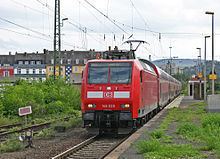Line length 226 km (140 mi) 6 Praest (until 2016) | ||
 | ||
Operating speed | ||
Niederl ndischer buffet wagen im d 414 rhein express nach hoek van holland erpel 5 juli 1985
The Rhein-Express is a Regional-Express (RE 5) service, which generally follows the Rhine (German: Rhein) river. It runs daily every hour from 5 am to 9 pm from Wesel via Oberhausen, Duisburg, Düsseldorf, Cologne, Bonn, Remagen and Andernach to Koblenz, in the German states of North Rhine-Westphalia and Rhineland-Palatinate. It is the fourth-most used regional express line in the VRR network with approximately 48,000 passengers a day.
Contents
- Niederl ndischer buffet wagen im d 414 rhein express nach hoek van holland erpel 5 juli 1985
- 20020325 rhein express d
- History
- Lines
- Rolling stock
- Contract
- References
Until the timetable change in December 2016, the Rhein-Express ran to/from Emmerich. Operations on this section and the additional services provided by Regionalbahn service RB 35 (Der Weseler) have since been operated as part of the Rhein-IJssel-Express (RE 19).
20020325 rhein express d
History
The Rhein-Express was established in 1998 with the introduction of the integrated regular interval timetable in North Rhine-Westphalia (called NRW-Takt) by combining two services that previously started or finished in Cologne. Originally, the RE 5 service stopped at almost all intermediate stations, as if it were a Regionalbahn service.
In December 2002, several intermediate stops and all overtaking by long-distance trains were eliminated, and the scheduled top speed was increased to 160 km/h, shortening the journey time by over 30 minutes between Cologne and Koblenz. The acceleration and the simultaneous thinning of services between Emmerich and Wesel reduced the number of sets of vehicles that was required for the circulation from nine to seven.
Hourly services of the Rhein-Express were restored at the timetable change in 2007 between Emmerich and Wesel in order to compensate for the thinning of RB 35 (Der Weseler) services on the Emmerich–Wesel–Duisburg route as a result of reduced funds for regional transport. In order to reach Emmerich in time for the return journey, it was necessary reduce stops at some minor stations to two-hour intervals in the direction of least loading.
The problematic section between Emmerich and Wesel was transferred with effect from December 2016 with the letting of the contract for the new Rhine-IJssel-Express (RE 19), since the Rhein-Express now only operates on the Wesel–Koblenz section.
The Rhein-Express has been operated since 1998 by DB Regio NRW, based at the depot at Cologne-Deutz. The operation of this service for the period starting in 2016 is due to be retendered.
Lines
The Rhein-Express uses four different lines with eight different route numbers:
In the four to six track section between Duisburg and Dusseldorf, the Rhein-Express and the NRW-Express (RE 1), use the long-distance tracks. The Rhein-Haard-Express (RE 2), the Rhein-Emscher-Express (RE 3), the Rhein-Weser-Express (RE 6), Rhein-Hellweg-Express (RE 11) and the Rhein-IJssel-Express (RE 19) use the so-called local tracks where they exist or the S-Bahn tracks.
Rolling stock
Originally, the Rhein-Express was operated with class 110 locomotives with and six modernised Silberling carriages without control cars. During 2002, the service was converted to push-pull train trains made up of newly delivered class 146 locomotives and five double-deck carriages. Because of flood damage at the manufacturer of the seats, the delivery of the double-deck carriages was delayed, so that until the summer of 2003 two sets of Silberling carriages could still be found on the service.
Between August and November 2011, the capacity was increased by another car, which means that each train now includes a first-class only carriage. This first-class car is usually coupled directly to the engine, while the two-class compartment is in the control car at the other end of the train.
Contract
Four public transport associations are involved in the operation of the Rhein-Express: the Nahverkehrs-Zweckverband Niederrhein (local transport association of the Lower Rhine), the Verkehrsverbund Rhein-Ruhr (Rhine-Ruhr public transport association), Verkehrsverbund Rhein-Sieg (Rhine-Sieg public transport association) and the Zweckverband Schienenpersonennahverkehr Rheinland-Pfalz Nord (Rhineland-Palatinate North rail transport association).
Tenders for the RE 5 were called on 31 January 2014 for the period from December 2018 to December 2033. Its route description was limited to the Wesel–Koblenz section and omitted the non-electrified Bocholt–Wesel railway.
Regionalbahn service RB 35, which supplemented the Rhein-Express until December 2016, ran mostly only between Wesel and Duisburg, but in the peak ran between Emmerich and Düsseldorf. It is to be extended from April 2017 across the Dutch border to Arnhem and it will then be renamed, in accordance with its international importance, the Rhine-IJssel Express (RE 19). The line number RB 35 is now being used for what used to be operated as the northern section of the Rhein-Niers-Bahn (RB 33), which today runs between Mönchengladbach and Wesel and in 2019 should then run to Essen.
As part of the so-called RRX interim contract, services are to be provided by DB Regio from December 2016 until the commissioning of RRX rolling stock.
